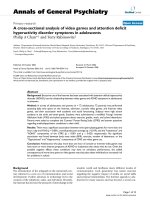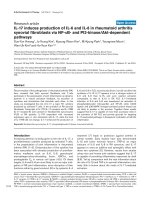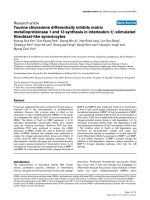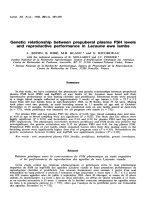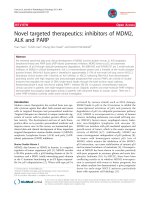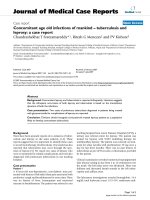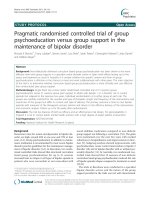Báo cáo y học: "The relationship between sales of SSRI, TCA and suicide rates in the Nordic countries" potx
Bạn đang xem bản rút gọn của tài liệu. Xem và tải ngay bản đầy đủ của tài liệu tại đây (330.43 KB, 9 trang )
RESEARC H ARTIC L E Open Access
The relationship between sales of SSRI, TCA and
suicide rates in the Nordic countries
Per-Henrik Zahl
1*
, Diego De Leo
2
, Øivind Ekeberg
3
, Heidi Hjelmeland
1,4
, Gudrun Dieserud
1
Abstract
Background: In the period 1990-2006, strong and almost equivalent increases in sales figures of selective serot onin
re-uptake inhibitors (SSRIs) were observed in all Nordic countries. The sales figures of tricyclic antidepressants
(TCAs) dropped in Norway and Sweden in the nineties. After 2000, sales figures of TCAs have been almost constant
in all Nordic countries. The potentially toxic effect of TCAs in overdose was an important reason for replacing TCAs
with SSRIs when treating depression. We studied whether the rapid increase in sales of SSRIs and the
corresponding decline in TCAs in the period 1990-98 were associated with a decline in suicide rates.
Methods: Aggregated suicide rates for the period 1975-2006 in four Nordic countries (Denmark, Finland, Norway
and Sweden) were obtained from the national causes-of-death registries. The sales figures of antidepress ants were
provided from the wholesale registers in each of the Nordic countries. Data were analysed using Fisher’s exact test
and Pearson’s correlation coefficient.
Results: There was no stat istical association (P = 1.0) between the increase of sales figures of SSRIs and the decline
in suicide rates. There was no statistical association (P = 1.0) between the decrease in the sale figures of TCAs and
change in suicide rates either.
Conclusions: We found no evidence for the rapid increase in use of SSRIs and the correspon ding decline in sales
of TCAs being associated with a decline in the suicide rates in the Nordic countries in the period 1990-98. We did
not find any inverse relationship between the increase in sales of SSRIs and declining suicide rates in four Nordic
countries.
Background
In many Western countri es, including Norway, Sweden,
Denmark and Finland, suicide rates have been declining
since the end of the 1980s [1,2]. The decline in Norway
and Sweden, from the end of the eighties onwards, has
been followed by relative stability over the l ast d ecade.
Overthesametimeperiod,the sales figures of antide-
pressants have increased in all the Nordic countries.
Selective serotonin re-upt ake inhibitors (SSRIs) were
introduced to the market around 199 0. The sales figures
of these drugs have subsequently increased year by year,
while t he sales figures of the potentially toxic tricyclic
antidepressants (TCAs) - drugs which can be quite toxic
in overdose - have been significantly reduced. Today,
SSRIs constitute about two-thirds of the total sales
figures of antidepressants in the Nordic countries [2].
To explain t he reduction in the suicide r ates seen in
many countries over the last decades, a number of
researchers have argued in support of an overall inverse
relation between sales of antidepressants and suicide
rates. For example, in a study published in 2000 by Isacs -
son in Sweden, the researcher argued tha t increased us e
of antidepressants “appeared to be one of the contribut-
ing factors to the decrease in the suicide rate”. In a recent
study on the sales of anti depressants and suicide rates in
Norway, the authors stated that the fall in suicide rates
was related t o the increased sales of non-tricyclic antide-
pressants, but only for the lower sales segment, indicating
that the switch from the more toxic TCAs could explain
the observed relationship [3].
In the Nordic countries, the suicide rates started falling
before the SSRIs were introduced [ 2]. In England and
Wales, a de clining trend co incided with the introduction
* Correspondence:
1
Department of Suicide Research and Prevention, Division of Mental Health,
Norwegian Institute of Public Health, Oslo, Norway
Full list of author information is available at the end of the article
Zahl et al. BMC Psychiatry 2010, 10:62
/>© 2010 Zahl et al; licensee BioMed Central Ltd. This is an Open Access article distributed under the terms of the Creative Commons
Attribution License ( licenses/by/ 2.0), which permits unrestricted use, distribution, and reproduction in
any medium, provided the original work is properly cited .
of SSRIs for young men, while the suicide rates have been
declining for three decades for young women [4]. Some
have been concerned that SSRIs may even increase sui-
cide risk in young people; however, there is no evidence
of an overall eff ect of regulatory a ctions to restrict pre-
scribing SSRIs to young people internationally [5].
Several published studies in favour of an inverse rela-
tionship between sales or use of antidepressants and sui-
cide rates were performed utilizing an ecological
research design. Some investigators have suggested that
the relationship was causal [6-10]. In contrast, a recent
review article based on publication p resenting data on
annual rates of completed suicide in relation to annual
rates of SSRI prescription/use over the past decades,
Safer and Zito concluded that “ available ecological evi-
dence does not support an inverse te mporal relationship
between rates of completed suicide and SSR I utilization”
[[11], p. 274], and “There is no consistent ecological pat-
tern of completed suicide in relation to SSRI usage”
[[11], p. 276]. Consistency is one of the Bradford Hill’s
criteria of causation [12].
Since the early nineties, suicide prevention has been
high on the political agenda in the Western world. Med-
ical treatment of depression is a main strategy for pre-
vention, and detoxification of substances has been an
important element in suicide prevention programs [13].
Thus, a reduction of suicide rates related to intoxication
from antidepressants may be expected when a large
number of people switch from using TCAs to using
SSRIs [3], similar to what happened when doctors
stopped prescribing barbiturates [14].
The aim of the paper is to study the relationship
between increased sales of SSRIs and changes in the sui-
cide rates in four Nordic c ountries in the time period
1990-98. A secondary aim is to study if the rapid switch
from TCAs to S SRIs in the early ninet ies had any
impact on the suicide rates in the same countries.
Methods
The suicide rates for the period 1975-2006 in four Nor-
dic countries (Denmark, Finland, Norway and Sweden)
were obtained from the national causes-of-death regis-
tries. In the period 1975-85, the c auses of death were
classified using the ICD (International Classification of
Diseases) 8th revision; in 1986-95 ICD-9 was used (not
in Denmark), and from 1996 the causes of deaths were
classified using the ICD-10 system. In the period 1991-
2006 there were 13,401 suicides in Denmark, 19,781 in
Finland, 8,821 in Norway and 19,975 in Sweden.
Altogether the statistical material covers 61,978 sui-
cides. In the previous period, 1975- 90, about 65,500 sui-
cides were recorded. National suicide rates are
presented as crude rates (suicides per 100,000 indivi-
duals) in Figure 1.
The sales figures of antidepressants were provided
from the wholesale registers in each of the Nordic coun-
tries. These data represent total sa les to pharmacies and
institutions. Even though the data are complete, they do
not necessarily represent consumption because not all
drugs being sold are consumed. In the Nordic countries,
drugs on the market are grouped according to the Ana-
tomical Therapeutic Chemical (ATC) classification. The
total national sales figures of ATC group N06A (all anti-
depressants), N06AB (SSRIs) and N06AA (TCAs) were
recorded, and the sales figures were standardised as
defined daily doses (DDD)/1,000 inhabitants/day for the
period 1975-2006. The sales figures are standardized as
DDD/1,000 inhabitants/day, and presented graphically
for all antidepressants (Figure 2), SSRIs (Figure 3) and
TCAs (Figure 4). Note that Danish sales figures are
missing in the period 1990-93.
To investigate the association between SSRIs, TCAs
and suicide rates, we have restricted the s tatistical ana-
lyses to the pe riod 1990-98 where changes in the SSRI
and TCA sales figures were largest and when one would
expect the largest fall in the suicide rates. We used a
non-parametric method to study th e associations . First
we calculated the annual differences (the difference
between numbers in two succeeding years) in the sui-
cide rates and the sales figures of SSRIs and TCAs,
respectively. We calculated eight differences for Finland,
Norway, and Sweden but 4 differences for Denmark
because sales figur es were missing for 1990-93. We stu-
died whether years with large increases in sale figure s
were associated with large drops in the suicide rates
using Fisher’s exact test [15] to calculate the significance
values for the 2 × 2 tables. Our null hypothesis wa s that
there is no association. The alternative is that t here was
either a strong negative or positive association. The lat-
ter, we believe, is not medically plausible.
First, we ranked the 28 annual differences in suicide
rates i nto four quartiles; there are seven differences in
each quartile (first column in Table 1). The correspond-
ing differences in the SSRI sales figures are presented
(second column in T able 1). Then we identified all SSRI
sales figure differences under the median difference.
Under the null hypothesis (there is no association
between the sales figures of SSRIs and the suicides) a
similarnumberofSSRIdifferencesbelowaswellas
above the median SSRI difference should have been
observed in each quartile of suicide differences.
We also used the same method to study whether
decreases in the sales figures of TCAs (third column in
Table 1) were associated with a decline in suicides rates.
This second statistical analysis is supplementary to the
analysis of the relationship between SSRIs and suicide
rates, but also an independent test of a possible relation-
ship between sales of TCAs and suicide rates.
Zahl et al. BMC Psychiatry 2010, 10:62
/>Page 2 of 9
0
5
10
15
20
25
30
35
1975 1977 1979 1981 1983 1985 1987 1989 1991 1993 1995 1997 1999 2001 2003 2005
Yea
r
Suicide / 100 000 / year
Figure 1 Suicide rates in Denmark (violet), Finland (black), Norway (red) and Sweden (blue) in the period 1975 to 2006.
0
10
20
30
40
50
60
70
80
1975 1977 1979 1981 1983 1985 1987 1989 1991 1993 1995 1997 1999 2001 2003 2005
Yea
r
DDD / 1000 inh / day
Figure 2 Total sale figures of antidepressants (N06A) in Denmark (violet), Finland (black), Norway (red) and Sweden (blue).
Zahl et al. BMC Psychiatry 2010, 10:62
/>Page 3 of 9
0
10
20
30
40
50
60
70
80
1991 1992 1993 1994 1995 1996 1997 1998 1999 2000 2001 2002 2003 2004 2005 2006
Yea
r
DDD / 1000 inh / day
Figure 3 Sale figures of SSRIs (N06AB) in Denmark (violet), Finland (black), Norway (red) and Sweden (blue).
0
1
2
3
4
5
6
7
8
9
10
1990 1991 1992 1993 1994 1995 1996 1997 1998 1999 2000 2001 2002 2003 2004 2005 2006
yea
r
DDD / 1000 inh / day
Figure 4 National sale figures of TCA (N06AA) in Denmark (violet), Finland (black), Norway (red) and Sweden (blue).
Zahl et al. BMC Psychiatry 2010, 10:62
/>Page 4 of 9
It is also possible to look at the distributions of SSRIs
and TCAs sales figures differences within each quartile.
When the re are 3 or 4 differences under the median in
each quartile, there is no significant association. One
may study all four quartiles simultaneously, or alterna-
tively, one can study first and forth quartile separately.
Finally we estimated the Pearson correlation coeffi-
cients for the differences, and we also studied how
much of the observed drop in su icide rates was actually
explained by a drop in intoxications.
Results
The N ordic suicide rates for the period 1975-2006 are
presented in Figure 1. Finland had the highest suicide
rates throughout the period. The suicide rates in Fin-
land, Norway, Sweden and Denmark have been declin-
ing after 1990. After 1999 there was a marginal, but not
significant fall in the suicide rates in Norway, Sweden
and Denmark ( P = 0.055 when testing for a trend using
a Poisson regression model adjust ing for country differ-
ences. Trends are still not significant when using an
autoregressive model for each country). The previous
difference between Norway, Sweden and Denmark is
almost eliminated, while Finland still has a higher rate
compared to the other three countries.
The total sales figures of antidepressants increased by
51 percent during the period 1975-1989 in the four
Nordic countries (Figure 2). In the period 1975-1989,
Finland had the lowest sales figures (the average sales
number was 4.7 DDD/1,000 inhabitants/day), while
Denmark had the highest ones (the averag e sale was 8.5
DDD/1,000 i nhabitants/day). Then, from the early 1990s
on to 2006, the sales figures started to increase from 10
to more than 50 in all four countries.
The national sales figures of SSRIs are presented in
Figure 3. The sales figures are constantly increasing in
the period 1991-2006 for all countries except Norway,
where the increase leveled out after 2004. In 2006, sales
Table 1 Ranked annual changes in suicide rates (first column), annual changes in the sales figures of SSRIs (second
column) and annual changes in the sales figures of TCAs (third column) in the period 1990-98
Differences in suicide rates Differences in sale figures of SSRI Differences in sale figures of TCA Country
-2.85 0.59 * -0.1 3
-1.88 0.29 * -0.3 * 3
-1.57 1.24 * 0 2
-1.5 3.99 -0.1 4
-1.49 5.17 -0.4 * 4
-1.47 9.46 -0.51* 1
-1.45 1.25 * -0.76 * 1
-1.19 -0.03 * 0.2 3
-1.13 0.10 * -0.2 4
-1.09 0.80 * -0.4 * 2
-0.96 3.40 0 3
-0.77 5.50 -0.83 * 1
-0.72 10.80 0.2 3
-0.69 7.10 -0.36 * 1
-0.69 -3.10 * -0.3 4
-0.68 3.80 -0.9 * 2
-0.6 1.90 * -0.8 * 2
-0.33 1.60 * 0.1 3
-0.06 1.80 * -0.1 3
0.03 2.90 -0.3 * 2
0.11 3.90 0.2 2
0.24 3.10 -1.2 * 2
0.27 1.60 * -0.12 1
0.3 1.50 * -0.54 * 1
0.32 4.00 -0.81 * 1
0.32 2.10 * -0.66 * 1
0.32 3.70 0.1 2
1.39 2.90 -0.1 3
In the fourth column, we have Norway (1), Sweden (2), Finland (3) and Denmark (4).
Differences in sales figures below the median are marked with a star.
Zahl et al. BMC Psychiatry 2010, 10:62
/>Page 5 of 9
of SSRIs constituted 67 percent of the total sales of
antidepressants in Norway, 73 percent in Sweden, 66
percent in Finland and 69 percent in Denmark. About
one-third o f the increase in SSRI sales figures is after
2000 when suicide rates are constant.
The sales figures of the TCAs in the period 1990-2006
are presented in Figure 4. Sales figures of TCAs in Den-
mark in the period 1990-93 were not available. How-
ever, total sales figures for antidepressants in Denmark
in these years were 8.5, 9.0 and 9.4, respectively. Assum-
ing the same percentage level of TCAs in Denmark as
in the other countries, compared to the total sales fig-
ures for antidepressants, the sales figures of TCAs
would be about 7.0 i n 1990-93. In 1990, the TCAs con-
stituted 65 percent o f all antidepressants in Finland, and
about 80 percent in the other three countries. In 2006,
the TCAs constituted 5-8 perc ent of all antidepressants;
however, the absolute fall from 1990 to 2006 was only
about 50 percent.
In Table 1, the 28 differences in t he suicide rates for
the four countries in the period 1990-98 are ranked in
the first column. The horizontal lines s plit the ranked
mortality differences into four quartiles with seven dif-
ferences in each. There are 14 differences in suicide
rates above the median (upper 14) and 14 differences
below the median (lower 14). The median suicide differ-
ence is -0.69. Negative differences indicate t hat the sui-
cide rate declined and positive differences indicate that
the suicide rate increased. In the second column, the
corresponding changes in the sales figures of SSRIs are
presented. These are not ranked (as the differences in
the f irst column), but the numbers marked with a star
are the differences in the sales figures bel ow the median
differences in the sales figures (the median is 2.5).
In Table 2, we present the 2 × 2 table for all outcome
variables; among the 14 lowest suicide differ ences (from
-2.85 to -0.69), there are seven SSRI differences under
the median SSRI difference and seven above; among
the14 highest differences (from -0.69 to 1.39) there are
also seven SSRI differences under t he median SSRI dif-
ference and seven above. The P-value in the exact Fisher
test is 1.0. The Pearson correlation coefficient between
differences in S SRI and suicide rates is 0.06 (P = 0.76).
We al so conducted a subgroup analysis of sales figures
differences in the first quartile (the seven largest drops
in the suicide rates) and fourth quartile (seven largest
increases in differences). The numbers of cases in each
cell are three or four, and the P-value is 1.0 when using
the Fisher test statistics.
ThechangesinthesalesfiguresofTCAsarepre-
sented in the third column in Table 1.
The Pearson correlation coefficient between TCAs and
SSRIs differences is -0.36. The n umbers marked with a
star are once again the differences in the TCAs sales fig-
ures below the median difference (the median difference
is -0.3). Here, the Pearson corr elation coefficient
between differences in TCAs and suicide rates is -0.10
(P = 0.76). In Table 3, the 2 × 2 table for all suicides
and TCAs differences is presented; the 28 differences
are equally distributed in all cells (as above) and the
P-values for the Fisher test is 1.0. We also considered
whether there was a lagged response on the suicide
rates. We studied the associations between changes in
TCAs sales figures in one year and the changes in the
suicide rates in the following year. However, this had no
effect on the results. Additionally, we looked at the asso-
ciation for only the data in the first quartile (the seven
largest drops in the suicide rates) and the fourth quartile
(the seven l argest increases in the suicide rate). The
number of cases in each cell is three or four, and the
P-value is 1.0 when using the Fisher test statistics.
Finally, we studied the proportion of suicides in Nor-
way caused by intoxication in the periods 1991-95 and
1996-2000. There were 2,960 and 2,725 suicides, respec-
tively. The numbers of suicides caused by intoxication
were 735 and 605, respectively. The drop in intoxication
was 130, while the drop in suicides was 235. Thus,
almost half of the drop in Norway is not explained by
the drop in intoxications, which is in accordance with
our statistical analyses.
Discussion
Two issues were in vestigated in the present study: 1)
whether there is a statistical inverse r elationship
between the sales of SSRIs and the suicide rates in four
Nordic countries in the time period 1990-98, and 2)
whether the switch from TCA s to SSRIs h as ha d a
significant impact on the suicide rate.
We found no negative association between the
increasing sales figures of SSRIs and the declining
Table 2 Numbers of SSRI differences and suicide rate
differences below and above the median.
SSRI differences
below median
SSRI differences
above median
Suicide rates below
median
77
Suicide rates above
median
77
Table 3 Numbers of TCA differences and suicide rate
differences below and above the median.
TCA differences below
median
TCA differences above
median
Suicide rates below
median
77
Suicide rates above
median
77
Zahl et al. BMC Psychiatry 2010, 10:62
/>Page 6 of 9
suicide rates in the period using our study design. We
did not find any association between the rapid decline
in the sales figures of TCAs and the simultaneous
decline in the suicide rates either.
The sales figures of antidepressant were slowly
increasing in all four countries before 1990 (Figure 2).
In contrast, the corresponding suicide rates differed
between the nations, increasing in Norway and Finland,
and slowly decreasing in S weden (Figure 1). After 1999,
sales figures of SSRIs are still increasing in Norway,
Sweden and Denmark, but there is no significant decline
in the corresponding suicide rates. Thus, there is no
consistency in the associations between the trends in
figures 1 and 2 before 1990. Consistency is one of the
Hill’s criteria of causation [12].
We wanted to see if a strong increase in sales figures of
SSRI in one year was associated with a strong decline in
suicide rates in the same year; i.e. if there was a dose-
response relationship. Our analysis is inspired by the
dose-re sponse causal criteria [12]. The analyses in Tables
2-3 are simplified versions of the Mantel-Haenszel
method [16], which is commonly used to study dose-
response relationships. Stratifying data into quartiles
instead of two groups also gave non-significant results.
The associations between the curves in fi gures 1 and 2
can also be studied us ing alte rnative s tatis tical met hods.
Correlation coefficients estimate the strength of a linear
association between two variables. Regression models
allow for adjustment of trends and confounding. Our
method does not assume linear relationship s and we do
not have to model the dose-response relationship either.
Because intoxication only accounts for about 25 per-
cent of all suicides and because intoxications are caused
by many other substances than TCAs, a simple calcula-
tion sh ows that a 50 percent decline in the absolute sales
figures of TCAs can only have a marginal effect on the
overall suicide rates, if there is any at all. For example, if
20 percent of all fatal intoxications are caused by TCAs
in Norway, then the predicted reduction in the suicide
rate is (20-10)/4% = 2.5%. This means that the observed
reduction in TCA sales figures can only explain a small
part of the observed reduction in suicide rates.
The two hypotheses above are related because many
people have switched from using TCAs to using SSRIs.
Because the sales figures of TCAs and SSRIs are nega-
tively correlated, one may argue that the statistical ana-
lyses are mathematically dependent. However, the
correlation coefficient is only -0.36, and of fourteen
TCA differences below the TCA median difference, only
six of the corresponding SSRI difference s w ere above
the median SSRI differences.
During the period 1990-98 the sales figures of SSRIs
increased more than the sales figures of TCAs declined,
allowing more people to be treated; however, there is no
association between increased sales of SSRIs and
decrease in the suicide rates. In contrast, Bramness et al.
[3] reported a small time-dependent inverse association
in Norway, but when including data from the other
Nordic countries, this association disappears. If
increased use of antidepressants (and more patients
being treated) prevents suicide, this will cause an under-
lying declining trend in suicide rates.
Our study of the relationship between sales of SSRIs
and suicide rates is using the same data as Reseland et
al.[2];however,theirconclusionisbasedonwhenthe
suicide rates started to decline and not on the direct
association between sales figures and suicide rates per
se. The decline in the suicide rates in Denmark and
Sweden pre-dated the introduction of SSRIs by ten years
or more, and the rates continued to decline thereafter
[2]. In Norway, the a ssociation was only present in the
first three years after the introduction of SSRIs, and dur-
ing the period when the major increase in sales of SSRIs
occurred, there were no major changes in the suicide
rates [2,3]. The estimated association reported in Nor-
way [3] is only valid for a small subset (less than 10 per-
cent) of the Norwegian data. In Finland, an association
between increased sales of antidepressants and reduction
of suicide rates has been demonstrated, but the effect
was not as strong for females as for males [2]. In Ice-
land, the sales figures are the highest in the Nordic
Countries, but suicide rates have been relatively constant
for 50 ye ars [17]. Thus, there is mixed evidence that
increased use of antidepressants has coincided with a
reduction in suicides [2].
The association between the decline in suicide rates in
Norway and the i ncrease in sales figures of SSRIs is dif-
ferent from the other Nordic countries. Initially, the
association is very strong but after three years (post
1994) there is no association. Thus, the conclusion by
Bramness and colleagues [3], that “ the fall in suicide
ratesinNorwayanditscountieswasrelatedtothe
increased sales of non-TCAs” seems n ot to be war-
ranted. The authors claim that the effect was mostly a
result of a sales increase in the lower sales segment
(page 1), due to “ achangefromthemoretoxicTCAs,
or heightened awareness of depression and its treatment
“( page 1). However, in Denmark there was no inverse
association betwe en sales of SSRIs and suicide rates in
thesameperiod,whiletherewassuchanassociation
after 1994. The same pattern was found in Sweden and
Finland, while there was no inverse association in Nor-
way aft er 1994. Further, in all Nordic countries, except
Norway, associations are also present in the higher sales
segment. Thus, in the present study, we have shown
that the claimed association in Norway [3] is contra-
dicted when using an alternative analysis and including
data from all Nordic countries. In the US, an inverse
Zahl et al. BMC Psychiatry 2010, 10:62
/>Page 7 of 9
association between the suicide rate and the use of
SSRIs has been demonstrated for the time period 1990-
2000, but more detailed analyses have revealed that the
association is only valid for older and male adolescents
residing in low-income regio ns. Furthermore, the ana-
lyses did not include factors like psycho- social interven-
tions and substance abuse [18]. In Australia, H all et al.
[7] claimed a link between increased use of SSRIs and
reduced rates of suicide. Their study attracted a number
of reactions, pointing at a simple shift in prescribing
full-dose SSRIs instead of low-dose TCAs [19] and a
marked pre-existing decline in elderly suicide rates [20],
ess entially related to the strong reduction in overdosing
on barbiturates as a suicide method [21]. In the words
of Sakinofsky [22], “Hall’s conclusion [ ] overstates the
evidence” (page 71).
The shift from TCAs to SSRIs in Denmark was similar
to that in Norway [23]. The proportio ns of TCAs in the
total sal es figures of antidepressants in Norway an d Den-
mark in 2001 were 9.5% and 11%, respectively. The pro-
portion of TCAs in the total sales in Norway in 1991 was
69%. We do not know the proportion in Denmark; how-
ever, before 1983, proportions were similar between Nor-
way and Denmark [23]. The inconsistencies between the
patterns in different countries are also shown by the dif-
ferent trends in Norway and Sweden during the period
1974-1988. The sales figures for antidepressants were
rather similar in the two countries, and slightly increasing
in bo th cases. During the same years, suicide rates in
Norway increased by approximately 70%, where as they
decreased slightly in Sweden. The reduction in the inci-
dence of suicides caused by intoxication in Norway can
explain about half of the drop in suicides in the 1990s.
Conclusions
This study was unable to find an association between
rapid increase in use of SSRIs and corresponding
decrease in sales of TCAs and the decli ne of suicide
rates in four Nordic countries during 1990-98. In parti-
cular, no evidence was detected of an inverse relation-
ship between the increase in sales of SSRIs and
declining suicide rates.
In interpreting these findings, we need to keep in mind
that there are factors in suicide phenomena that we still
do not know [24 ]. Time concomitances in trends across
nations and, sometimes, across cultures remain puzzling,
especially when we try to understand why suicide rates
have fallen both in countries that have and do not have a
national suicide prevention strategy [1,25]. As far as we
know, var iables that are more difficult to measure tha n
sales of antidepressants, such as cohort effects and other
cultural influences, could theoretically have a bigger
impact on suicide rates than any drug or psychotherapeu-
tic/psychosocial treatment. Yet, at this stage, we are unable
to convincingly co mprehe nd suicide phenomena, includ-
ing suicide trends. Combining different disciplines and
competencies appears to be the most logical way of feed-
ing hopes in overcoming the present difficulties [25-27].
We need to take into account that other suicide preventive
measures have also been implemented since the early
nineties, and might as well account for at least some of the
reduction in suicide rates.
This study was restricted to national rates of suicide.
It did not consider, as other investigations did [5,7],
trends distinctively examined by gender and age groups.
Furthermore, the study did not cons ider aspects such as
under-prescription and under-treatment of depressed
patients, their eventual compliance, and efficacy of anti-
depressants. A balanced review of curr ent controversies
in ecological studies on antidepressants and suicide can
be found, for example, in Sakinofsky [22].
Lastly, the quality of the national suicide rat es depends
on the autopsy rates [28], which may vary over time and
between countries. However, this problem may affect all
kind of study designs, not only ours. Help-seeking and fear
of stigmatization in patients (crucially important in effec-
tive therapies) were also left aside, as well as other factors
able to influentially interact with suicide trends, such as
alcohol consumption, illicit drugs use, and unemployment.
With all these limitations kept in mind, we found no evi-
dence that th e rapid shift from using tricyclic antidepres-
sants to using selective serotonin re-uptake inhibitors was
associated with a decline in the suicide rates.
Author details
1
Department of Suicide Research and Prevention, Division of Mental Health,
Norwegian Institute of Public Health, Oslo, Norway.
2
Australian Institute for
Suicide Research and Prevention, Griffith University, Mt Gravatt Campus,
Brisbane, QLD, Australia.
3
Department of Acute Medicine, Ullevaal University
Hospital, Oslo, and Department of Behavioural Sciences in Medicine, Institute
of Bas ic Medical Sciences. Faculty of Medicine, University of Oslo, Norway.
4
Department of Social Work and Health Science, Norwegian University of
Science and Technology, Trondheim, Norway.
Authors’ contributions
PHZ, DDL and GD conceived the project. PHZ collected data and GD wrote
the first draft. PHZ performed the statistical analyses. All authors have
contributed to writing and revising the manuscript, and all authors read and
approved the final manuscript.
Competing interests
The authors declare that they have no competing interests.
Received: 3 September 2009 Accepted: 6 August 2010
Published: 6 August 2010
References
1. De Leo D, Evans R: International suicide rates and prevention strategies
Göttingen, Hogrefe & Huber 2004.
2. Reseland S, Bray I, Gunnell D: Relations between antidepressant sales and
secular rates in the Nordic countries. Br J Psychiatry 2006, 188:354-358.
3. Bramness J, Walby FA, Tverdal A: The sales of antidepressants and suicide
rates in Norway and its counties 1980 - 2004. J Affect Disorders 2007,
102:1-9.
Zahl et al. BMC Psychiatry 2010, 10:62
/>Page 8 of 9
4. Biddle L, Brock A, Brookes ST, Gunnell D: Suicide rates in young men in
England and Wales in the 21st century: time trend study. BMJ 2008.
5. Wheeler BW, Metcalfe C, Martin RM, Gunnell D: International impacts of
regulatory action to limit antidepressant prescribing on rates of suicide
in young people. Pharmacoepidem Dr Safe 2009, 18:579-588.
6. Grunebaum MF, Ellis SP, Li SH, Oquendo MA, Mann JJ: Antidepressants
and suicide risk in the United States, 1985-1999. J Clin Psychiat 2004,
65:1456-1462, 2004.
7. Hall WD, Mant A, Mitchell PB, Rendle VA, Hickie IB, McManus P: Association
between antidepressant prescribing and suicide in Australia, 1991-2000:
trend analysis. BMJ 2003, 326:1008-1013.
8. Isacsson G: Suicide prevention - a medical breakthrough? Acta Psychiatr
Scand 2000, 102:113-117.
9. Olfson M, Shaffer D, Marcus SC, Greenberg T: Relationship between
antidepressant medication treatment and suicide in adolescents. Arch
Gen Psychiat 2003, 60:978-982.
10. Rihmer Z, Kalmar S, Belson N: Antidepressants and suicide prevention in
Hungary. Acta Psychiatr Scand 2001, 103:238.
11. Safer DJ, Zito JM: Do antidepressants reduce suicide rates? Public Health
2007, 121:274-277.
12. Hill B: The environment and disease: Association or causation? Proc R Soc
Med 1965, 58:295-300.
13. World Health Organization: SUPRE Prevention of suicidal behaviours: a
task for all. 2008 [ />information/en/index.html].
14. Nielsen AS, Nielsen B: Pattern of choice in preparation of attempted
suicide by poisoning with particular reference to changes in the pattern
of prescription [In Danish]. Ukeskr Laeger 1992, 154:1972-1976.
15. Fisher RA: The logic of inductive inference. J Royal Statist Society (Series A)
1935, 98:39-84.
16. Mantel N, Haenszel W: Statistical aspects of the analyses of data from
retrospective studies of disease. J Natl Cancer Inst 1959, 22:719-748.
17. Helgason T, Tómasson H, Zoäga T: Antidepressants and public health in
Iceland. Time series analysis of national data. Br J Psychiatry 2004,
184:157-162.
18. Van Praag HM: The resistance of suicide: why haven’t antidepressants
reduced suicide rates? Prevention and treatment of suicidal behaviour: from
science to practice Oxford, Oxford University PressHawton K 2005, 239-260.
19. Ankarberg PH: Antidepressant prescribing and suicide - antidepressants
do not reduce suicide rates. BMJ 2003, 327:288-289.
20. Draper B: Antidepressant prescribing and suicide - associations attribute
possible causality inappropriately. BMJ 2003, 327:288.
21. De Leo D: Suicide in Australia: What we know and what we don’t know.
An Australian-Japanese Perspective on Suicide Prevention: Culture, Community,
and Care Canberra, Commonwealth of AustraliaDe Leo D, Herrman H, Ueda
S 2006, 10-19.
22. Sakinofsky I: Treating suicidality in depressive illness. Part I: Current
controversies. Can J Psychiat 2007, 52(Suppl 1):71S-84S.
23. Health Statistics in the Nordic Countries 1982: NOMESCO Copenhagen 1984.
24. Gmel G, Rehm J, Ghazinouri A: Alcohol and suicide in Switzerland. An
aggregate-level analysis. Drug Alcohol Review 1998, 17:27-37.
25. De Leo D: Suicide prevention is far more than a psychiatric business.
World Psychiatry 2004, 3:155-156.
26. De Leo D: Struggling against suicide. The need for an integrative
approach. Crisis 2002, 23:23-31.
27. De Leo D: Why are we not getting any closer to preventing suicide?
(Editorial). Br J Psychiatry 2002, 181:372-374.
28. Reseland S, Le Noury J, Aldred G, Healy D: National suicide rates 1961-
2003: further analysis of Nordic data for suicide, autopsies and ill-
defined death rates. Psychother Psychosom 2008, 77:78-82.
Pre-publication history
The pre-publication history for this paper can be accessed here:
/>doi:10.1186/1471-244X-10-62
Cite this article as: Zahl et al.: The relationship between sales of SSRI,
TCA and suicide rates in the Nordic countries. BMC Psychiatry 2010 10:62.
Submit your next manuscript to BioMed Central
and take full advantage of:
• Convenient online submission
• Thorough peer review
• No space constraints or color figure charges
• Immediate publication on acceptance
• Inclusion in PubMed, CAS, Scopus and Google Scholar
• Research which is freely available for redistribution
Submit your manuscript at
www.biomedcentral.com/submit
Zahl et al. BMC Psychiatry 2010, 10:62
/>Page 9 of 9
